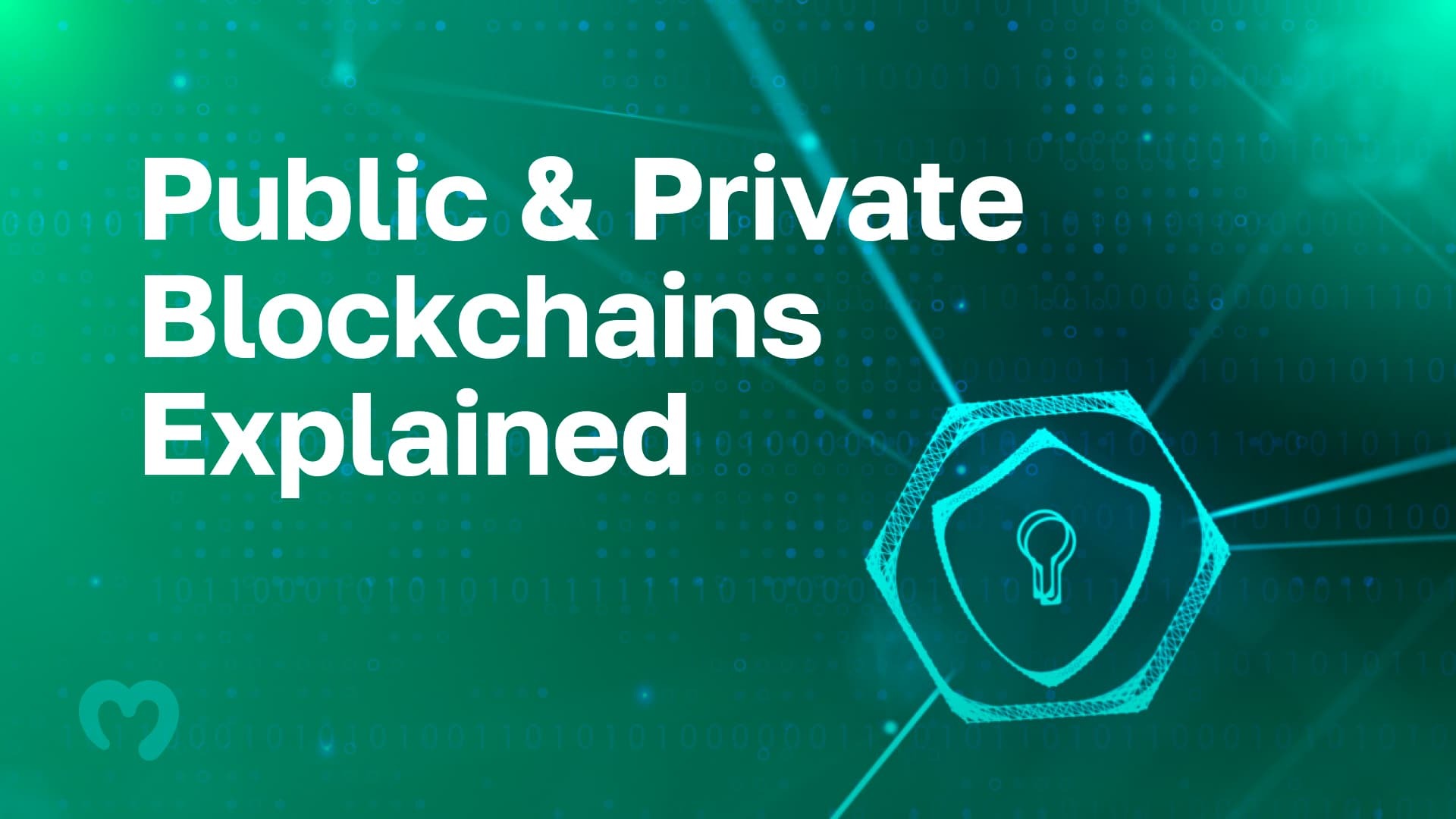Herein, we dive deep into the underlying technology powering Web3 – blockchain! Specifically, this article considers the two main types of chains available: public and private blockchains. Moving forward, we discuss these chains’ advantages and disadvantages, their similarities and differences, and much more. So, if you want to find an answer to the “what is the difference between public and private blockchains?” question, read on!
Public vs Private Blockchains: What is the Difference?
A public blockchain is a network everyone can access as long as an internet connection is established. In comparison, a private blockchain is only accessible to those with permission. So, for example, a company may have a blockchain network of its own for employees. Now, can you think of a public blockchain? How about Bitcoin and Ethereum?
Blockchains such as Bitcoin and Ethereum are accessible to the public. Take Ethereum, for example. Anyone can access Ethereum, interact with dapps built on top of it, execute transactions, etc. Accordingly, a chain such as this is a public blockchain.
So, there is clearly a distinct difference when comparing public vs private blockchains. But, are there any clear similarities between them? Let’s find out!
Similarities Between Public vs Private Blockchains
Both private and public blockchains are “append-only”, meaning that the network can only have information or data added to it, and participants in the network can not alter it. Furthermore, this particular feature of the blockchain technically means that the blockchain is immutable. The only rare case that can change this occurs if a hacker gains a majority of the network’s “hash power” (51%).
No “update” or “delete” options are available in neither the public blockchain nor the private blockchain. The information in a blockchain is time-ordered, sequential data. Furthermore, transactions appear in blocks that form a chain of data. This feature is especially useful because it allows for accuracy, accountability, and transparency. Every individual using the respective blockchain can see every single transaction that ever takes place.
What is a Private Blockchain?
The major difference between a private blockchain and a public blockchain is quite obvious; a private blockchain runs privately. Even though blockchain is meant to be decentralized, private blockchain networks inherently become centralized. The organization or company can administer who has access to the blocks. Also, a private blockchain is more centralized, highly scalable, and consumes less energy.
A private blockchain is also sometimes known as a “permissioned blockchain”. Although a private blockchain requires an authority to monitor who has access to the blockchain, it can be less secure. With fewer participants in the network, taking control of the data can become almost effortless for any potential attackers. Moreover, since a private blockchain maintains only a few nodes, it would be easier for a hacker to take over the network.
Advantages of Public Blockchains
The advantage of a public blockchain is that it is truly decentralized and democratized. Anyone can participate in the network. There is no single authority to govern it. One advantage of a public blockchain is that the more participants there are in the network, the safer it becomes. The more nodes there are within the network, the more complex it becomes for hackers to gain control.
Even though they are permissionless, public blockchains are ideal for entities that don’t have natural trust. Further, they rarely have counterparties. For example, data regarding the entire history of a car can be on the blockchain. Accordingly, the blockchain ledger can track all of its sales, repairs, and updates to provide an accurate car history.
Another significant advantage of public blockchains is that they are compatible with any type of business application due to their open-source nature. There are no restrictions on the kind of data a blockchain contains. Businesses are already using blockchain to store records of medical transactions, documentation, identity information, supply chain records, etc. Even more phenomenal is that anyone in any part of the world can access the blockchain. As long as they have internet access, anyone can easily access instant global transactions on the blockchain.
Finally, another appealing feature of a public blockchain vs private blockchain is anonymity. Private blockchains require a unique identity for participants. A public blockchain spreads a transaction across a public ledger as bits of data, so it’s impossible to trace the identity to just one user.
At Moralis, we’ve empowered more than 100,000 companies to build, launch, and scale projects. With Moralis’ enterprise-grade APIs, including the NFT API, Solana API, and EVM API, you can access all kinds of data across most blockchains.
Disadvantages of Public Blockchains
One clear disadvantage of a public blockchain is its energy consumption. Take Bitcoin as an example. Its public blockchain operates using a proof-of-work (PoW) mechanism. PoW means the nodes compete with each other to complete the transaction and receive a reward. However, this process can be energy intensive and take a significant amount of time. Another disadvantage of public blockchains is that a public blockchain many times processes transactions at a slower speed.
Also, while more participants in the blockchain provide more security in the public blockchain vs private blockchain, it significantly slows down transaction time. Compared to private blockchains, the scalability issues with public blockchain burden the network with its many transactions.
Another disadvantage of a public blockchain is the lack of complete privacy. Since anyone can access transactions in a public blockchain, they can see sensitive information. In turn, if the identity of an address is revealed, anonymity is gone. Additionally, most current public blockchains are designed for cryptocurrencies which could attract hackers and thieves with ill intentions.
To learn more about crypto terminology or how to invest during a crypto bear market, check out our articles and tutorials on Moralis Academy. We’ve put together all the essential resources you need to go from beginner to expert at your own pace.
Why Use Private Blockchains?
One of the most attractive features of a private blockchain is its scalability. Since they do not occupy so many transactions and participants, private blockchains have a remarkably fast transaction speed, especially in comparison to a public blockchain network.
When a company wants to have a network it can personally control and grant private access to; a private blockchain is the number one choice. These private blockchains can process thousands of transactions in a matter of seconds.
While it’s not decentralized as blockchain technology originally intended to be, a private blockchain has one setback – it’s more susceptible to malicious attacks. In many cases, private blockchain networks are centralized and rely on very few nodes. This way, hackers can take over and gain control of the entire network more easily, putting a company at great risk.
In a private blockchain, the network operator can grant access to who can read, write, and add to the ledger. Plus, the operator can decide on the allocation of nodes across the network. Businesses usually resort to a private network to build business applications that offer high scalability and a trusted environment.
Are Private Blockchains Better Than Public Blockchains?
The kind of blockchain network an entity chooses to use depends on its individual use case. As public blockchain networks become more secure over time, private blockchain networks become less critical.
A private blockchain should be the go-to option if scalability and control are a priority. Private blockchain allows for customized access to the blockchain, providing more control and faster transactions within the network. Also, since users in a private blockchain can not remain completely anonymous, it puts more trust in the network. That said, a private blockchain network is excellent for businesses prioritizing scalability and control.
However, it is important to consider the centralized network. The limited number of nodes in this kind of network can give hackers a better opportunity to attack than in a public blockchain network.
Check out our blockchain guides for tutorials and cryptocurrency guides. We’ve put together a wide selection of free educational materials covering everything from blockchain basics to advanced coding tutorials, such as how to build a decentralized social media profile!
Why is Anonymity Important Anyways?
Anonymity and privacy are significant parts of the success of blockchain technology. When individuals and companies perform transactions, they may wish to keep the information from public knowledge.
In a blockchain, transactions can trace back to the original wallet addresses. But that’s just numbers on a private key without any other identifying information tied to them. Let’s compare it with the legacy system. A standard bank account would have all the identifying information on an individual or company. Further, banks keep information such as name, address, SSN, and other sensitive details. Keys, however, only identify a wallet with which the transaction is made.
The kind of anonymity that blockchain provides can help prevent users from becoming targets of kidnapping and theft. Blockchain users can securely perform transactions from the comfort of wherever they are in the world in just a matter of minutes, no matter what day of the week it is or the hour of the day. Additionally, unlike banks, blockchain networks do not have operating hours.
Unfortunately, anonymity on the blockchain is a double-edged sword. While the technology keeps its participants anonymous, this can provide opportunities for criminally driven activities such as money laundering and human trafficking.
Regulations and Blockchain Technology
While cryptocurrencies and blockchain technology provide phenomenal opportunities for instant global transactions, they can easily become a vehicle for criminal activity. The US Treasury has emphasized the need for urgent regulations on cryptocurrency trading and blockchain transactions, but the finite details are still unclear.
Currently, cryptocurrency transactions are the primary use case for most public blockchains. Regulations for these cryptocurrency transactions are evolving every day all over the world. Cryptocurrency regulations are essential in combatting criminal activity, but they can also cause an inconvenience for those who want complete privacy and anonymity.
Furthermore, only a few countries accept cryptocurrencies as legal tender. Some countries, like the US, are leaving it to their states to decide the full scope of legality for crypto transactions and exchanges. In China, cryptocurrency has been declared illegal, and even entire exchanges have been banned in the country. Also, China has a firm hold on its stance on cryptocurrency restrictions, and it doesn’t look like China will loosen up its bans any time soon. However, Chinese citizens are still able to find ways to work around the ban by using platforms that China’s firewall can’t catch.
Some exchanges in the United States have already started reporting suspicious activity reports (SAR) for any blockchain transactions of $10,000 or more. These exchanges, such as Coinbase, also require wallet owners to identify recipients of transactions of $3,000 or more in a single transaction.
Public vs Private Blockchains – Summary
So, we’ve discussed the pros and cons of public vs private blockchains, their most favored features, and their drawbacks. We’ve discussed how anonymity plays a role in public vs private blockchain and why it may be necessary.
What is the most outstanding difference between public vs private blockchains? The most significant difference between them is their scalability, but in the end, deciding which one to use will depend on your particular use case and priorities. If you prefer complete control over your network and to process thousands of transactions in a matter of minutes, you might want to stick to a private blockchain. However, if you prefer an open-source environment and anonymity is a priority over scalability, your go-to option is a public blockchain.
Public vs private blockchains, which one is more secure? Public blockchain technology is becoming more and more secure each day as more nodes join the network. Private blockchain, on the other hand, provides scalability and private access.
If you like learning about blockchain technology and want to know how to make a Web3 website, among other projects, check out our Moralis Academy. We’ve got blockchain guides, Web3 ebooks, and complete tutorials on all things blockchain and Web3.
Learn More About Blockchain
With Moralis Academy, quickly learn the skills you need to successfully understand public vs private blockchains and use blockchain for your business or personal needs. Moreover, we’ve got tools to teach you about crypto trading, crypto terminology, how to build dapps, NFTs, and so much more. What’s more, our courses allow you to go at your own pace and give you challenging tasks to reinforce learning as you go.








